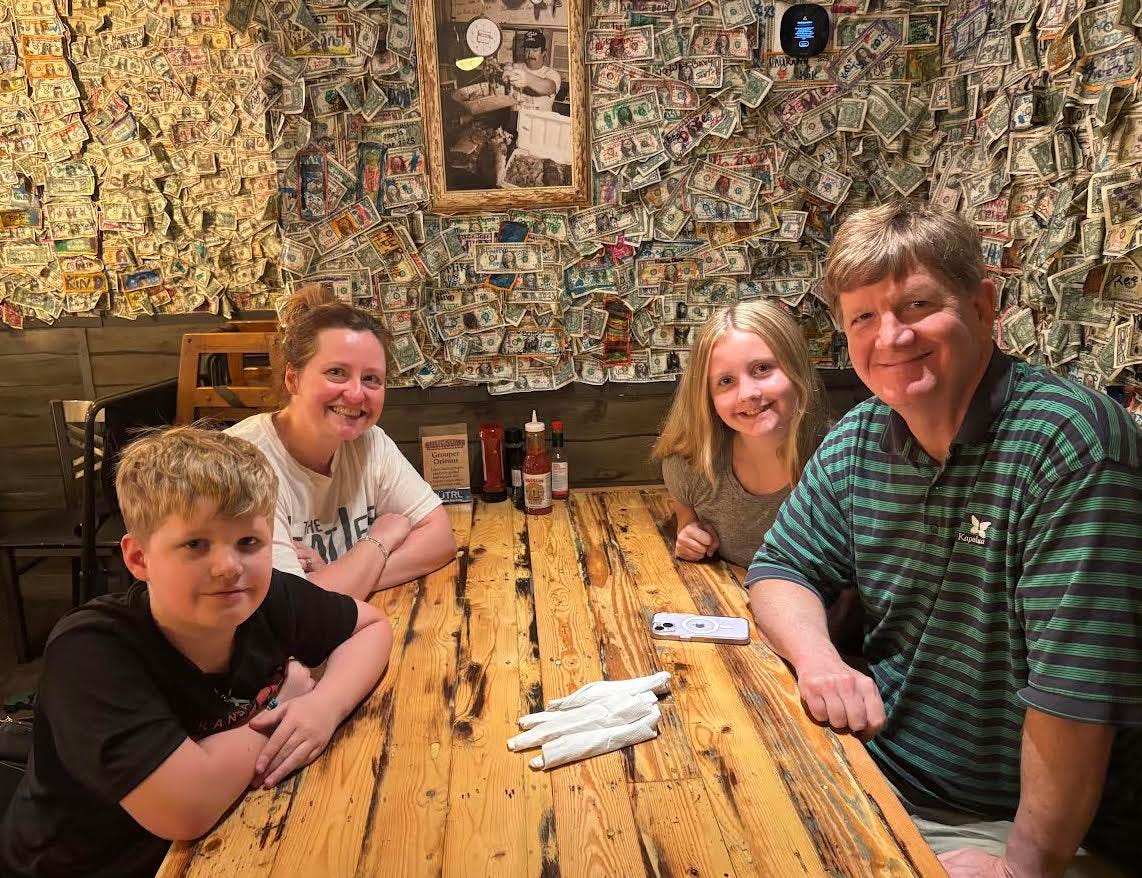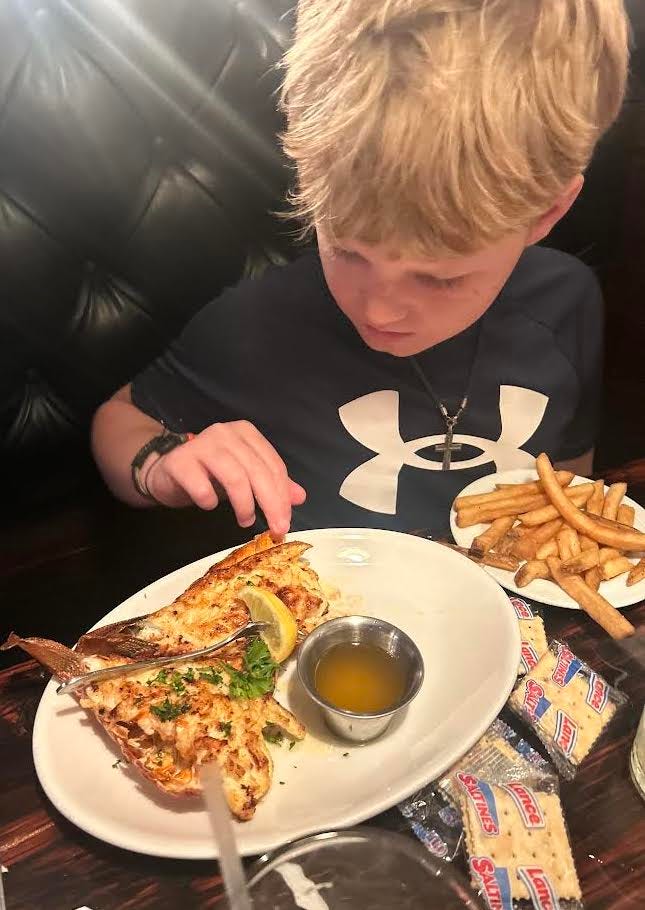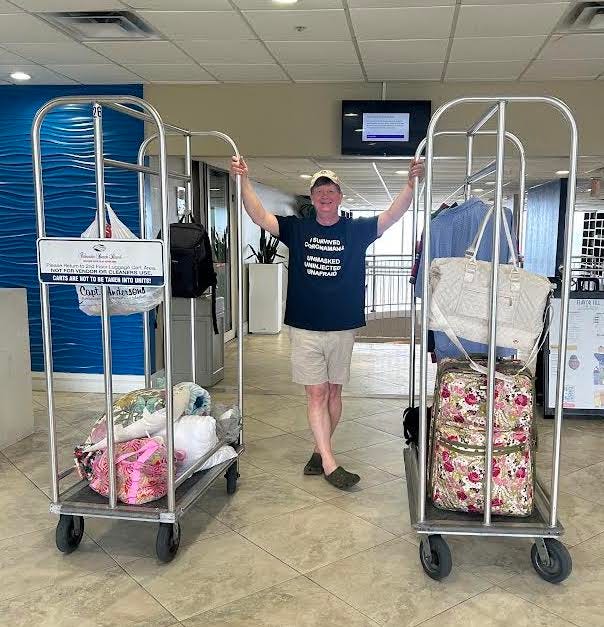Family outing to PC shows all’s not lost in the world …
I don’t get out of town much so when I do I want to share a few world observations.

We probably couldn’t afford it, but the Rices still decided to make a few family memories and recently booked a two-night stay at a condo at Panama City Beach, Florida. I signed off on PC Beach because this is where everyone in Troy vacationed when I was growing up.
I wanted to take my kids, 9 and 13, to the same places my late parents once took me and I also wanted to make some observations about how this beach community and (people) might have changed in 40 years.
It’s possible to document the good, the bad and the disconcerting about America circa 2025 from making a few mental notes in a contemporary travel journal. In today’s dispatch, I’ll document the Good ….
For me, the high point of the 3-day “vacay” were dining experiences at two of PC Beach’s landmark restaurants and a beach rite of passage - racing go-karts.
When we arrived in PC around noon Sunday, we had 4 hours to kill before we could check into our condo (a maddening experience I may or may not chronicle in Part 2, “the Bad and disconcerting.”)
While my daughter Maggie wanted to eat at another place for our first beach lunch, I exercised Daddy privileges and vetoed her request.
This was fun in 1983 …
“We’re going to eat at Shuckums,” I said.
I’d discovered Shuckums in my glory years of the early 1980s. Back then this “restaurant” was simply a small oyster shack that had not been fully enclosed. If I remember correctly, the menu consisted of just two items - a dozen oysters on the half shell and a pitcher of cold draft beer.
(This reminds me of one of Alabama’s iconic restaurants, the original Dreamland BBQ in Tuscaloosa, where the menu selections are still just three items - a slab of ribs, white bread and cold beer).
Still, Shuckums’ limited menu selection, lack of walls or air-condition was enough to make Shuckums a PCB landmark.
Forty years later, Shuckums has now added square footage and has walls, air condition and a full menu, but it’s still excellent.
Shuckums, which opened in 1967, was also the first restaurant I remember where patrons, after writing their name or some clever artistic memes on the currency, tacked dollar bills on the walls.
If Shuckums had five thousand one-dollar bills on the walls in 1983, it now must have $100,000 in dollar bills tacked on the walls (each dollar about 10 deep).
Somewhere in that dollar-bill wall paper must be a couple of “Bill Rice, Jr.” autographs from the same place, but another time. (From a picture on the wall in the little gift shop by the cash register, I learned that the owner since 1982 is a big Alabama fan. “See,” I told Jack, “our tribe is everywhere.”)
I also wonder how many people, if any, have poached a few of those dollar bills through the years or if the government taxes that art work as gratuities.
Since my wife was our designated driver, I ordered a fruity rum drink and, soon enough, was in happy Beach mode.
The food and service were excellent and the kids were blown away by the floor-to-ceiling dollar bills.
Dad’s first restaurant executive decision earned a thumbs up. Upon reflection, I think what I was really looking for were signs that some things in America are still great and/or proof that at least some businesses have stood the “test of time.”
Probably because this business hasn’t changed ownership in 43 years, Shuckums is still great.
Captain Anderson’s has aged very well …

On Monday night, we all got gussied up, piled in the car and drove all the way down “back beach road” to Capt. Anderson’s, the most famous restaurant in PC Beach and one of the best-known restaurants in our part of the world.
“The kids have to eat at Captan’s A’s just like I did as a kid and teenager,” I explained to my wife. Carrie agreed, which was good, since she was paying for the meal on her school teacher/career coach salary.
(Note: Per Captain Anderson’s website, the restaurant, which opened in 1966, serves more than 250,000 diners every year!)
I am happy to report that all the features that made Captain Anderson’s standout in my memory still exist today.
The food, service and decor couldn’t have been better and, once again, Maggie and Jack were happy Dad made a command restaurant decision.
(An ulterior motive for this trip might have been an effort to prove to my children that Dad, at least sometimes, knows what he’s doing).
Jack, 9, ordered boiled shrimp for an appetizer and (a lifetime first!) lobster tails for an entree - both items quickly rating a 10 on Jack’s culinary scale.
For my part, I was impressed by the efficiency of the staff and the business formula the restaurant’s owners have kept the same for many decades.
Despite being the most popular restaurant in northern Florida, our wait was only 45 minutes, time we pleasantly killed by strolling across the piers admiring the chartered fishing boats that dock late every afternoon just a short cast from the restaurant proper.
From decades ago, I still vividly remember checking out the fishing boats, the closest I’ve ever gotten to being a character in a Jimmy Buffet song.
Other patrons waited for their tables outside next to a giant fishing boat anchor or in the handsomely-adorned and comfortable lobby or in Captain A’s lounge, which we adults also availed ourselves of, ordering two more “beach drinks.”
Here, I confess that I’m a bar/lounge snob and Captain Anderson’s earns a “10” on my decor/layout scale.
The lounge isn’t too big, but it isn’t too small and the light fixtures (decorative sea shells), varnished tables and wall lockers (with vintage scotch and wines) made me feel like I was right where I should be at the moment.
In fact, I wondered why all the patrons waiting for their tables weren’t relaxing and soaking in the same decor like we were. (Perhaps the $17 “beach drinks” deterred some customers, but not us!)
Just like our hostess told us, it was indeed “about 45 minutes” before our Table of 4 number was called and we were seated for dinner.
Our waitress was an African-American lady of about 35 who’d long ago mastered how to perform this demanding job.
Per waitress chit-chat, we learned our server had a five-year-old son, who also loved shrimp and lobster tails. We also learned waiting tables at Captain Anderson’s was one of three jobs she holds. Her other two jobs are selling real estate and working as some kind of “government consultant,” which is always a great job.
Still, neither job probably pays as well as waiting tables at Captain Anderson’s where an 18-percent gratuity nets a waiter or waitress at at least $40 to $75 per table (more, it occurred to me, than I make from a paid subscription on Substack).
Even the bus boys at Captain Anderson’s are a joy to behold. When a group leaves a table, two or three men rapidly emerge, clean the table to spotless condition in about 45 seconds, getting it ready for the next table to order their seafood, complimentary hush puppies and bread and extra beach drinks, beer and wine.
(Random observation: Captain Anderson’s also still brings packaged crackers to the table, which every restaurant used to do, but few do today).
Takeaway: It takes many hard-working people to make a restaurant function like it should … but teamwork makes the memories - and repeat customers - possible!
According to Carrie, her she-crab soup was the best she’d ever had - better than what she had on a girls’ weekend trip to Charleston. (Question: Is there such a dish as he-crab soup and why are the crab’s pronouns feminine?)
We lucked out as our window view was of the fishing boats.
While scanning the menu and sipping my Captain Anderson’s special ale, I also enjoyed looking at the framed photographs which depicted this same section of Panama City Beach 50 to 60 years ago. Most of the people in the photographs are long gone, but they’d be happy to know one captain figured out how to navigate the changing tides of the future.
In praise of the remaining ‘beautiful people’ ….
I also appreciated that most of the diners made an effort to dress up a little before going to Captain Anderson’s. Many diners still wore short pants, but they were nice short pants with nice shirts and I didn’t see any diners wearing tank tops showing off their underarm hair and tattoos.
“Look, these people look normal,” I whispered to my wife.
Since I had a warm little, Gulf of America buzz, I went further, opining that a good percentage of Captain Anderson’s clientele might even rate as “attractive.”
Inappropriate Beach observation: per my memories, the percentage of “attractive people” seems to have been higher four decades ago, an observation I admit might be my stubborn elitism/snobbery (or traditionalism/conservatism) sneaking out.
“This is why we pay premium prices,” I commented to Carrie, who gave me a sour look, meaning I should keep these politically incorrect views to myself.
In my defense, I note that such observations are not completely novel as I recently read a similar travel piece from Naomi Wolf, who delicately tried to make the same point while writing about a recent trip to New York City. According to Ms. Wolf, most women in our New Normal times don’t seem to be going out of their way to make themselves presentable to the world.
If the standard of the “feminine mystique” has, shall we say, evolved in recent years, the same can be said for the masculine mystique … and I think both changes in appearance are probably inter-related.
I also noted that most tables included at least one man aged 60 to 75, who I deduced was the person “picking up the tab,” reaffirming my belief that rich retirees are single-handedly keeping nice restaurants in business.
Younger patrons probably go to Captain Anderson’s like we do - once every couple of decades - to remember how families used to act before restaurant inflation wasn’t quite as conspicuous.
When my late father took our family to such restaurants, he always said, “order whatever you want,” which we did, making the kids think we were probably wealthier than we really were. What Mom and Dad were paying for was happy memories and reminding us there was more to the world than a McDonald’s Happy Meal.
(If Dad had been seated next to a patron sporting a tank top, his displeasure would have been instantly known, which makes me somewhat glad Dad didn’t live to see the world’s changing “fashion sense.”)
These asides aside, Dad would have thoroughly enjoyed this particular dining experience and would have no doubt left a nice tip.
Gentlemen, start your engines!
My No. 3 top PC Beach postcard was the family’s outing to one of PC Beach’s go-cart racing tracks. This one - 9/10ths of a mile - is purported to be the longest race course in Northwest Florida.
I also insisted on this outing only because I had once enjoyed racing go karts when I was a child and thought my two young racers would enjoy the same experience, which they did.
The track employees even let 9-year-old Jack pilot a solo go-cart after, briefly deliberating on whether Jack was old enough or big enough to go solo.
The go-karts had bumpers and the employees made sure we were all safely buckled up, allowing Jack to race his Mom, Dad and older sister.
Maggie, 13, beat us all fair and square and Jack quickly figured out how to steer through the S’s and take his foot off the gas where needed.
While six laps cost $31 a person, Carrie and I decided the memories were worth the price tag.
The Big Race made us all slightly sore, making me realize NASCAR races are more physically demanding on drivers than I’d perhaps realized.
When your kids re-hash an outing for hours and parents take in these smiles, it occurs to you they might always remember such an event and will, no doubt, one day bring their own kids to a go-cart track at the beach.
Who knows? One day, Maggie and Jack might take their own families to Shuckums and Captain Anderson’s and think of the trip when their mother and father took them to the same places … which will make them smile.
When that happens, I’ll perhaps be watching from Heaven, my soul further lifted with the knowledge that maybe I did a few things right.
*** (I still can’t crack the “Top 100” of Health Politics. This piece might better fit in the Culture category or leaderboard.) ***





UPDATE: Before we headed south to PC, I stated I'd update readers on a couple of my recent "page view" metrics, which I'm monitoring like a hawk these days.
My story from a week ago on "The Curious Substack Leaderboards" has generated only 3,380 page views in a week, which is the lowest "page view" metric I've had in probably two years.
I don't think the algorithms were amused.
My story on "Mayor Pete" joining Substack's All-Stars generated approximately 3,800 page views, which is about 700 fewer than I've been averaging in the past month.
My story "In Praise of Transcriber B" did better, generating about 4,500 page views. I was interested in monitoring these numbers as two years ago I published another story about Transcriber B. That story generated 18,500 page views and 52 new subscribers. My latest story generated 4 new subscribers (1/13th of my previous number).
But Mayor Pete has added 25,000 subscribers since I wrote about him.
For a fun game/geography lesson, I told the kids we should take note of where all the license plates were from. I can confirm that we identified license plates from at least half the states in the union. I think Alabama might still have been the most-common license plate, but nothing like it was when I used to come down to the beach in the late 1970s and early 1980s.
Back then, at least half of the license plates would be from “the heart of Dixie,” which is not overly surprising if you realize the Alabama border is only about 45 miles from Panama City Beach.
Back then, Alabamians might as well have considered the beaches of the Florida Panhandle as an unofficial part of our state. This is because state residents in every large city and small town seemed to own rustic beach houses and cabins (which are now all giant condos and strip shopping centers).
At some point, perhaps when MTV started doing weeklong specials from PC Beach, everyone else in the country discovered “our” beaches.
It was actually always a point of state pride that so many Alabamians once owned “beach places” as the national stereotype said that Alabama was the nation’s second poorest state, perhaps behind Mississippi.
This might have been true, but a huge number of poor Alabamians had places at the beach, which mean that, even if your family didn’t have a beach place, you’d be invited to stay with friends whose family did.
Also, when I was in high school and college, you could still find several “roach motels” where you could stay for $40 or $50/night.
Those days/places are also gone with the wind.
I recently read that the “Panama City” metro area is the fastest-growing metro area in the country.
I think northerners who used to retire to central or south Florida have now also discovered northern Florida, which, culturally, used to be more like a Southern state than the “Northern” areas of south and central Florida.
My wife told me a distant cousin lives in Panama City (not the Beach but the town, which is 15 miles east of the beaches) and recently listed her fairly modest home. The asking price is $1.4 million!
Take-away: People are definitely re-locating to the “Free State of Florida,” even the once “Redneck” area of the state. But the rednecks that used to come down to Florida all the time were actually pretty refined and not that different than people from anywhere else - maybe even nicer.
Still, when 50 percent of the car tags used to say “Alabama,” that figure today might be 10 percent.